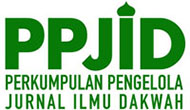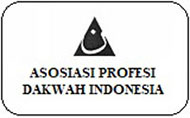New Ustazah: Hijrah & Transformation of Da'wa Authority among Celebrities in Indonesia
Abstract
This study examines the phenomenon of celebrities who have undergone hijrah (spiritual migration) and subsequently taken on roles as religious preachers. The rise of celebrity ustazah significantly impacts the da'wa landscape, altering both the authority and perception of Islamic propagation. Many celebrities embracing hijrah not only undergo spiritual transformation but also contribute to a shift in the structural dynamics of religious outreach. Through these channels, celebrity ustazah emerge as influential religious figures, sometimes challenging established authorities. Using a qualitative netnographic method, this research gathers data from online news, social media, and YouTube. The study finds that the authority of celebrity ustazah is formed through intertwined aspects such as popularity, personal transformation, piety, and social engagement. However, methodological and scope limitations necessitate further in-depth exploration of this phenomenon.
Keywords
Full Text:
PDFReferences
Abdullah, I. (2017). Di Bawah Bayang-Bayang Media: Kodifikasi, Divergensi, Dan Kooptasi Agama Di Era Internet. Sabda: Jurnal Kajian Kebudayaan, 12(2), 116–121. https://doi.org/https://doi.org/10.14710/sabda.12.2.116-121
Abdullah, R., Sabran, R., Kasmani, M. F., Ramle, N. A., Mohd Ariffin, M. Y., & Nurdin Marjuni, K. (2018). Ustaz Cool, Ustazah Trendy: Chiselled Islamic Celebrity Preachers. Al-Abqari: Journal of Islamic Social Sciences and Humanities.
Abdurrahman, M. S. (2020). Generasi Muda, Agama Islam, dan Media Baru (Studi Kualitatif Perilaku Keagamaan di Shift Gerakan Pemuda Hijrah, Kota Bandung). Anida (Aktualisasi Nuansa Ilmu Dakwah), 20(1), 46–63.
Addini, A. (2019). Fenomena gerakan hijrah di kalangan pemuda muslim sebagai mode sosial. Journal of Islamic Civilization, 1(2), 109–118.
Ahmad, M., Muniroh, S. M., & Nurani, S. (2021). Niqab, Protest Movement, and the Salafization of Indonesian Islam. QIJIS (Qudus International Journal of Islamic Studies), 9(2), 423–462.
Akmaliah, W. (2020). The Rise of Cool Ustadz: Preaching, Subcultures, and the Pemuda Hijrah Movement. In A. N. B. Saat, Noorshahril (Ed.), The New Santri: Challenges to Traditional Religious Authority in Indonesia. ISEAS Publishing Singapore.
Al-Qardhawi, D. Y. (2007). Retorika Islam : Bagaimana seharusnya menampilkan wajah Islam (kedua). Pustaka Al-Kautsar.
Ali, M., Maskuroh, N., Ritonga, D., Wahid, M., & Hasanah, U. (2017). Ulama Perempuan Banten Dari Mekah, Pesantren, dan Majlis Taklim untuk Islam Nusantara (Masykur & Umdatul Hasanah (ed.)). Blidung Nusantara.
Aminah, A. N. (2018, November). Oki Setiana Dewi Luruskan Niat dalam Berdakwah Mengajak kebaikan bukan hanya tugas seorang ustaz, melainkan tugas semua orang. Republika.Co.Id. https://khazanah.republika.co.id/berita/phxg11384/oki-setiana-dewi-luruskan-niat-dalam-berdakwah
Arnold, T. W. (2019). Sejarah Lengkap Penyebaran Islam (Indonesia). IRCiSoD.
Aziz, J. A. A. (1997). Ad-Da’wah Qawa’id wa Ushul. Daarud Da’wah.
Billahi, S., & Thaha, I. (2018). Bangkitnya Kelas Menengah Santri Modernisasi Pesantren di Indonesia. Prenada Media.
Bruinessen, M. (1990). Kitab kuning; Books in Arabic script used in the Pesantren milieu; Comments on a new collection in the KITLV Library. Bijdragen Tot de Taal-, Land- En Volkenkunde / Journal of the Humanities and Social Sciences of Southeast Asia. https://doi.org/10.1163/22134379-90003218
Burhanuddin, J. (2002). Ulama Perempuan Indonesia (J. Burhanuddin (ed.); Cet Ke-I). Gramedia Pustaka Utama.
Dawud, M. (2016). TAYANGAN DAKWAH DAN LAHIRNYA DA’I SELEBRITI. Al’Adalah, 18(2).
Demichelis, M. (2019). “Fasad, Hijra and Warlike Diaspora” from the Geographic Boundaries of Early Islam to a New Dar al-Hikma: Europe. Religions, 10(4), 277.
Duraesa, M. A., & Ahyar, M. (2021). Islamic Popul [ar] ism: Religious Popularism and Activism in the Yukngaji Community. QIJIS (Qudus International Journal of Islamic Studies), 9(2), 503–534.
Geatri, T. (2022). Masih Ingat Peggy Melati Sukma? Dulu Cerai Ditipu Suami, Kini Hijrah dan Ganti Nama Artikel ini telah tayang di TribunManado.co.id dengan judul Masih Ingat Peggy Melati Sukma? Dulu Cerai Ditipu Suami, Kini Hijrah dan Ganti Nama, https://manado.tribunnews. TribunManado.Co.Id. https://manado.tribunnews.com/2022/06/10/masih-ingat-peggy-melati-sukma-dulu-cerai-ditipu-suami-kini-hijrah-dan-ganti-nama?page=all
Hamka. (2018). Prinsip dan Kebijaksanaan Dakwah. Gema Insani Press.
Hamudy, N. A., & Hamudy, M. I. A. (2020). Hijrah Movement in Indonesia: Shifting Concept and Implementation in Religiosity. JSW (Jurnal Sosiologi Walisongo), 4(2), 133–150.
Haryadi, D. (2020). Otoritas Keagamaan Baru: Habituasi dan Arena Dakwah Era Digital. Islamic Insights Journal, 2(2). https://doi.org/10.21776/ub.iij.2020.002.02.01
Hasanah, U. (2017). Majelis taklim perempuan dan perubahan sosial pada masyarakat perkotaan. PKBM “Ngudi Ilmu".
Hasanah, U. (2020). Kualifikasi Da’i: Komparasi Konseptual Retorika Dakwah dan Retorika Aristoteles. Jurnal Komunikasi Islam, 10(2), 256–275.
Hasanah, U., & Anam, K. (2022). The Polemic of Wayang in Da’wah Stage: Digital Contestation for Religious Authority. Jurnal Dakwah Risalah, 33(1), 35–56.
Hasanah Umdatul & Nurasia T. (2022). Da’wah Policy Controversy: A Case Study of Discourse on Standardization and Certification of Da’i in Indonesia. Ilmu Dakwah: Academic Journal for Homiletic Studies, 16(1). https://doi.org/10.15575/idajhs.v16i1.16531
Helmiannoor, H., & Musyarapah, M. (2019). Eksistensi dan Dedikasi Ulama Perempuan Terhadap Pendidikan Islam di Nusantara. SYAMIL: Jurnal Pendidikan Agama Islam (Journal of Islamic Education), 7(2), 87–99.
Hew, W. W. (2018). THE ART OF DAKWAH: social media, visual persuasion and the Islamist propagation of Felix Siauw. Indonesia and the Malay World. https://doi.org/10.1080/13639811.2018.1416757
Higgins, C., & Walker, R. (2012). Ethos, logos, pathos: Strategies of persuasion in social/environmental reports. Accounting Forum. https://doi.org/10.1016/j.accfor.2012.02.003
Hjavard. (2008). The mediatization of religion: A theory of the media as agents of religious change. Northern Lights. https://doi.org/10.1386/nl.6.1.9/1
Hosen, N. (2019). Challenging Traditional Islamic Authority: The Impact of Social Media in Indonesia. Proceedings of International Conference on Da’wa and Communication, 1(1). https://doi.org/10.15642/icondac.v1i1.280
Istigfarin, A. A., Mardhia, I., & Aulia, R. N. (2021). PENGARUH ARTIS HIJRAH TERHADAP PERUBAHAN DIRI FOLLOWERS INSTAGRAM@ KAJIANMUSAWARAH. Penamas, 34(1), 43–58.
Khoiriyah, M. (2017). Mantap Bercadar, Umi Pipik Ungkap Cerita Haru Perjalanan Hijrah. Okezonecelebrity.Com. https://celebrity.okezone.com/read/2017/08/10/33/1753453/mantap-bercadar-umi-pipik-ungkap-cerita-haru-perjalanan-hijrah
Kholili, H. M. (2023). Reconceptualization of the Da’wah Movement in Indonesia: Perspectives on Da’wah Communication. Interdiciplinary Journal and Hummanity, 2(3), 219–238. https://doi.org/https://doi.org/10.58631/injurity.v2i3.40
Khotimah, K. (2017). EPISTEMOLOGI ILMU DAKWAH KONTEMPORER. KOMUNIKA: Jurnal Dakwah Dan Komunikasi. https://doi.org/10.24090/komunika.v10i1.862
Kim, H.-J. (2010). Praxis and Religious Authority in Islam: The Case of Ahmad Dahlan, Founder of Muhammadiyah. Studia Islamika, 17(1). https://doi.org/10.15408/sdi.v17i1.468
Kloos, D. (2019). Experts beyond discourse: Women, Islamic authority, and the performance of professionalism in Malaysia. American Ethnologist, 46(2), 162–175.
Kloos, D., & Künkler, M. (2016). Studying Female Islamic Authority: From Top-Down to Bottom-Up Modes of Certification. Asian Studies Review, 40(4). https://doi.org/10.1080/10357823.2016.1227300
Kozinets, R. (2010). Netnography: Doing Ethnographic Research Online.
Kulavuz-Onal, D. (2015). Using Netnography to Explore the Culture of Online Language Teaching Communities. CALICO Journal, 32(3), 426–448.
Lyansari, K. N. (2018). Hijrah celebrity creating new religiosities, branding economics of lifestyle in the age of Muslim mass consumption. Analisis: Jurnal Studi Keislaman, 18(2), 211–232.
Lyansari, K. N. (2020). KULTUR SELEBRITI, KOMODIFIKASI DAN KESALEHAN NARASI HIJRAH PEGGY MELATI SUKMA. UIN SUNAN KALIJAGA YOGYAKARTA.
Lyansari, K. N. (2022). Celebrification and Branding New Female Religious Authority in Indonesia. Dialog, 45(1), 99–110.
Mahestu, G., & Sumbogo, T. (2020). Marketing of Identity Politics in Digital World (Netnography Study on Indonesian Presidential Election 2019). https://doi.org/10.1109/ICIMTech50083.2020.9211242
Majid, N. (2008). Islam, kemodernan, dan keindonesiaan. Mizan Pustaka.
Meuleman, J. (2011). Dakwah, competition for authority, and development. Bijdragen Tot de Taal-, Land-En Volkenkunde/Journal of the Humanities and Social Sciences of Southeast Asia, 167(2–3), 236–269.
Mpofu, P., Asak, M. O., & Salawu, A. (2022). Facebook groups as transnational counter public sphere for diasporic communities. Cogent Arts & Humanities, 9(1), 2027598. https://doi.org/10.1080/23311983.2022.2027598
Muhammad, K. H. H. (2020). Perempuan ulama di atas panggung sejarah. IRCiSoD.
Murthy, D. (2008). Digital Ethnography: An Examination of the Use of New Technologies for Social Research. Sociology, 42(5), 837–855.
Mustafa, Z., Nordin, B., & Yusuf, N. (2018). Da’wah Transformation Method In The New Millenium. Gading Journal for Social Sciences (e-ISSN 2600-7568), 21(02), 27–36.
Muthohirin, N. (2021). Da’wa in Social Media: The Views of Ustad Hanan Attaki and Felix Siauw to The Hijrah Phenomenon. Afkaruna: Indonesian Interdisciplinary Journal of Islamic Studies, 17(2), 249–270. https://doi.org/DOI: https://doi.org/10.18196/afkaruna.v17i2.12671
Mutia, T. (2021). Da’wahtainment: The Creativity of Muslim Creators in Da’wah Communication on Social Media. Jurnal Dakwah Risalah, 32(2), 147–163.
Natsir, M. (1996). Fiqhud Da’wah (ke-10). Capita Selecta.
Nisa, E. F. (2018). Social media and the birth of an Islamic social movement: ODOJ (One Day One Juz) in contemporary Indonesia. Indonesia and the Malay World, 46(134), 24–43.
Pamungkas, A. S. (2018). Mediatisasi dakwah, moralitas publik dan komodifikasi Islam di era neoliberalisme. Maarif: Arus Pemikiran Islam Dan Sosial, 13(1), 55–75.
Puspasari, D. (2018). Menikah, Cerai, dan Hidup Kacau, Titik Hijrahnya Peggy Melati Sukma Baca artikel detikhot, “Menikah, Cerai, dan Hidup Kacau, Titik Hijrahnya Peggy Melati Sukma” selengkapnya. Detikhot. https://hot.detik.com/celeb/d-4039593/menikah-cerai-dan-hidup-kacau-titik-hijrahnya-peggy-melati-sukma.%0A
Qudsy, S. Z. (2019). Pesantren Online: Pergeseran Otoritas Keagamaan di Dunia Maya. Living Islam: Journal of Islamic Discourses, 2(2), 169–187.
Rahayu, H. (2022). Representasi Dan Citra Visual Artis Hijrah Di Media Online. DeKaVe, 15(1), 62–75.
Rahmah, N. (2018). Khazanah Intelektual Ulama Betawi Abad Ke-19 Dan Ke-20 M. Jurnal Lektur Keagamaan, 16(2), 195–226.
Rengkaningtias, A. U. (2018). Wacana Keulamaan Perempuan Dalam Teks Ikrar Kebon Jambu. Musawa Jurnal Studi Gender Dan Islam, 17(1), 32–50.
Rohmaniyah, I., Indiyanto, A., Prasojo, Z., & Julaekhah, J. (2022). Redefining status through burqa: Religious transformation and body politics of Indonesia’s woman migrant workers. HTS Teologiese Studies/Theological Studies, 78(4), 7270.
Saputra, E. (2022). Marketing Da’wah Through New Media at the" Teras Dakwah”(Da’wah Terrace) Yogyakarta, Indonesia. Jurnal Dakwah Risalah, 33(1), 1–16. https://doi.org/DOI: http://dx.doi.org/10.24014/jdr.v33i1.18159
Saputra, E. H., Ghazali, M. B., Mukmin, H., Wiranto, B. B., & Yanti, F. (2021). Understanding da’wah and khatib. Linguistics and Culture Review, 5(S1), 274–283.
Sari, T. Y., Husein, F., & Noviani, R. (2020). Hijrah and Islamic Movement in Social Media: A Social Movement Study of Anti-Dating Movement# IndonesiaTanpaPacaran. DINIKA: Academic Journal of Islamic Studies, 5(1), 1–26.
Setianto, Y. P. (2015). Mediatization of Religion: How the Indonesian Muslim Diasporas Mediatized Islamic Practices. Journal of Media and Religion. https://doi.org/10.1080/15348423.2015.1116268
Setyawan, A. (2020). Dakwah yang Menyelamatkan: Memaknai Ulang Hakikat dan Tujuan Da’wah Islamiyah. Al-Adabiya: Jurnal Kebudayaan Dan Keagamaan, 15(02), 189–199.
Smith, B. J., & Wardatun, A. (2022). Domestic violence and Islamic spirituality in Lombok, Indonesia: women’s use of Sufi approaches to suffering. Contemporary Islam, 1–21.
Solahudin, D., & Fakhruroji, M. (2020). Internet and Islamic learning practices in Indonesia: Social media, religious populism, and religious authority. Religions, 11(1), 19. https://doi.org/https://doi.org/10.3390/rel11010019
Sugito, M. S., & Hasanah, U. (2016). PENDAKWAH PERAEMPUAN DI MASA NABI SAW.
Sugiyono. (2022). Metode Penelitian Kualitatif, Kuantitatif dan R & D. Alfabeta.
Sulaiman, M., & Ahmad, M. N. (2017). Return To The Almighty: Documenting Islamic Awareness And The Spiritual Migration Of Malaysian Artists. Adved 2017: 3rd International Conference On Advances In Education And Social Science.
Sunesti, Y., Hasan, N., & Azca, M. N. (2018). Young Salafi-niqabi and hijrah: agency and identity negotiation. Indonesian Journal of Islam and Muslim Societies, 8(2), 173–198.
Taimiyah, I. (1995). Etika Beramar Ma ruf Nahi Munkar. Gema Insani.
Triana Windy .et.al. (2021). Contemporary Hijrah Movement in Indonesia. Convey Report-Convey Indonesia PPIM Jakarta -UNDP Indonesia, 4(3).
Triantoro, D. A. (2018). Dakwah Dan Kesalehan: Studi Tentang Gerakan Teras Dakwah Di Kalangan Remaja Yogyakarta. Jurnal Masyarakat Dan Budaya, 20(2), 273–286.
Turner, B. S. (2007). Religious authority and the new media. Theory, Culture & Society, 24(2), 117–134.
Utami, A. (2022). 5 Artis Indonesia yang Jadi Ustazah, Rela Tinggalkan Dunia Hiburan. Sindonews. https://lifestyle.sindonews.com/read/846311/187/5-artis-indonesia-yang-jadi-ustazah-rela-tinggalkan-dunia-hiburan-1659600516?showpage=all%0A%0AUntuk membaca berita lebih mudah, nyaman, dan tanpa banyak iklan, silahkan download aplikasi SINDOnews.%0A- Andr
Volpi, F., & Turner, B. S. (2007). Introduction: Making Islamic Authority Matter. In Theory, Culture & Society (Vol. 24, Issue 2). https://doi.org/10.1177/0263276407074992
Wai Weng, H. (2022). Packaging, Persuasion and Propaganda: Popular Preaching and Islamic Counter-publics in Indonesia. Asian Studies Review, 1–16.
Yunus, A. H. (2019). Hijrah. Emik, 2(1), 89–104.
Zahara, S., Fabiani, R. R. M., YW, T. Z., & Humaedi, S. (2020). Penyalahgunaan Napza Dalam Dunia Entertainment. Focus: Jurnal Pekerjaan Sosial, 3(2), 165–170.
Zaidan, A. K. (1985). Ushulu al-Da’wah. Muassasah al-Risalah.
DOI: http://dx.doi.org/10.24014/jdr.v36i1.35926
Refbacks
- There are currently no refbacks.

This work is licensed under a Creative Commons Attribution-ShareAlike 4.0 International License.
Editorial Office:
2nd Floor, Building of Faculty of Da'wah and Communication, Universitas Islam Negeri Sultan Syarif Kasim Riau. Jl. HR Soebrantas Km 15, Simpangbaru, Tampan, Pekanbaru
Email : jurnalrisalah@uin-suska.ac.id

This work is licensed under a Creative Commons Attribution-ShareAlike 4.0 International License.














